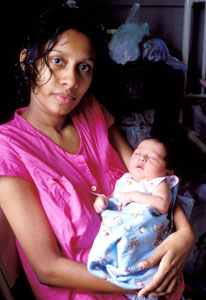The Human Microbiome Project: Research shows promise, may result in treatments
September / October 2013 | Volume 12, Issue 5

Photo by K M Asad / Photoshare
The NIH Human Microbiome Project has revealed
global differences that may have health implications.
By Arthur Allen
NIH-funded studies of the human microbiome - the collective genomes of all microorganisms present in or on the body - are revealing surprises that may result in actionable discoveries. These could someday lead to new approaches to treat malnutrition, asthma, obesity, diabetes and other conditions but the research is still in its early stages.
Scientists met recently to review progress made under
NIH's Human Microbiome Project and consider future directions for "this very exciting area of science, which is just bursting with opportunity and potential for understanding aspects of human health that had been outside our reach until recently,"
said Dr. Francis S. Collins, NIH director [Video].
NIH began exploring this emerging area of science in 2006 with a five-year, $115 million Common Fund initiative involving a handful of institutes and centers (I/Cs). The effort now has broad NIH interest and support - with about $180 million awarded in extramural funds in FY 2012 - and includes international partners in Canada, Korea, Australia and the European Union.
"We've just begun to scratch the surface," Collins observed. NIH would like to move the field forward, he added, "to better understand how disruptions in that superorganism result in disease and what we can do about it."
Since the discoveries are relevant across the I/Cs, NIH would like to develop a more cohesive approach, identify opportunities for resource sharing and develop collaborations across the agency and with other U.S. government partners.
In 2012, the National Human Genome Research Institute (NHGRI) launched a three-year program to survey the human microbiome and its genetics by sequencing the contents of the gut, skin, mouth, nose and reproductive tract of 300 men and women. The project has already generated the largest mass of biological data ever gathered, showing that some 10,000 microbial species with 8 million unique genes colonize American adults,
according to NGHRI director Dr. Eric Green [Video]. Other studies have compared the microbiomes of Westerners with those in cities and rural areas of the developing world.
"These efforts truly have catalyzed the field of microbiome research in a very productive way," Green said.

Photo by Dominic Sansoni / World Bank
NIH-funded researchers are studying
the link between nutrition and the
microbiome in the hopes of
discovering interventions that could
improve health.
The balance of different microbe species in and on human bodies changes throughout life and particularly in different phases of pregnancy. Examinations of microbes in the stool of women in their third trimester of pregnancy show increased levels of certain inflammatory substances that trigger hormonal changes, weight gain and higher blood glucose - processes that help women support their fetuses.
Many of these organisms are then passed along to babies during childbirth.
Dr. Maria Gloria Dominguez-Bello, a Venezuelan-born microbiologist currently at New York University, spoke [Video] with concern about the growing number of C-sections. Her research shows that passage through the vaginal canal colonizes babies with particular bacterial families, and she speculated that lack of exposure might explain why C-section babies are at greater risk of developing Type 1 diabetes, celiac disease, asthma or obesity.
"We tend to blame environmental contamination or diet on problems like asthma," Dominguez-Bello said. "Now we're recognizing that there's an interaction with microbes and the environment and microbes and us. When we disrupt the microbiome it may have consequences that, while not life-threatening, affect our health."
Dr. Martin Blaser, an infectious disease specialist at New York University, noted [Video] that food companies routinely fatten livestock by feeding them antibiotics on a nontherapeutic basis. Studies in mice show that the antibiotics shift the microbial balance in the animals' guts, stimulating inflammatory processes that lead to faster weight gain. Blaser asked whether excessive antibiotic use against childhood infections might be contributing to human obesity through the same mechanisms.
Some of the research discussed pointed to possible dietary interventions to improve health.
Dr. Wendy Garrett, an immunologist at the Harvard School of Public Health, described [Video] how dietary compounds called short-chain fatty acids - the best-known of which is acetic acid, the main component of vinegar - stimulate certain microbes in the gut that in turn stimulate production of immune cells, called regulatory T-cells, that suppress inflammation.
A similar role for microbes and regulatory T-cells was
noted by Dr. Susan Erdman [Video], a veterinarian at the Massachusetts Institute of Technology. When she fed mice on probiotic bacteria called
Lactobacillus reuteri, or a yogurt made with the bacteria, they remained healthy while eating the same junk food diet as their fatter cousins. The males had greater testicular growth, while the females had shinier coats and were more affectionate toward their offspring, Erdman said. The promising data on the benefits of lactic acid bacteria made her pose the question, "Is there some kind of intervention using these well-characterized strains that might be of enormous benefit for an immediate public health remedy for some types of conditions?"
But
Dr. Jesse Goodman, chief scientist at the Food and Drug Administration, injected a note of caution [Video], noting that masses of data can lead to hasty conclusions. "Systems biology gives you the ability to propose biological plausibility for almost anything," he said. "Manipulating the microbiome must be based on the best science, with a healthy respect for the complexity of nature."
While many presentations made microbial diversity sound like an unmitigated good, that could be a misapprehension. People in Malawi, Burkina Faso and the Amazon all have greater microbial diversity in their guts than Westerners, but also suffer more intestinal infections and die younger.
To illustrate this point,
Dr. Kathryn Dewey of the University of California, Davis, noted [Video] that gut microbiota in rural populations of Burkina Faso were more diverse than those of Europeans and richer in microbes that feed off of starches, fibers and plant polysaccharides. Such organisms are thought to ward off inflammatory microbes.
"But I don't want to give the impression that this is a better diet in any way," Dewey said. "In this particular situation we could not argue that Burkinabe children were protected against these microbes, because diarrheal diseases are very, very common there."
Dewey has conducted much of her research among severely malnourished children in Malawi. She and other scientists are interested in examining the extent to which malnutrition may result not just from inadequate food, but a breakdown in microbial communities that process different parts of the diet.
The relationship between malnutrition and microbial communities is complex, Dewey said. Her research will evaluate the relationship among breast- and formula-feeding, first foods and the development of intestinal microbes and the immune system in various countries of Africa, South Asia and South America. Her goal is to assess the impact of lipid-based nutrient supplements on microorganisms and infant health.
The microbiome studies have already revealed "surprising" things, Collins said. "There's a lot of complexity here but it's beginning to look as if the fog is lifting and we're able to see some of the principles and some of the conclusions that might even become, before long, actionable."
More Information
- Related news:
The Human Microbiome Project expands the toolbox for studying host and microbiome interactions
NIH Common Fund news, May 29, 2019 - Related news:
Our Microbes Are a Rich Source of Drugs, UCSF Researchers Discover
University of California San Francisco news, September 11, 2014 - Videos and presentations from the
July 2013 meeting, Human Microbiome Science: Vision for the Future, including the videos of presentations mentioned above on the NHGRI YouTube channel,
GenomeTV:
-
Supercharging Science for the Superorganism by Francis S. Collins, M.D., Ph.D., NIH
-
NIH Human Microbiome Project: An Update by Eric D. Green, M.D., Ph.D., NHGRI
-
Keynote 2: The Modern vs Ancestral Microbiome by Maria Dominguez-Bello, Ph.D., New York University
-
Microbiome and Obesity by Martin J. Blaser, M.D., New York University
-
Microbial Metabolites and their Regulation of Colonic Regulatory T Cell Homeostasis by Wendy S. Garrett, M.D., Ph.D., Harvard School of Public Health
-
Wound Healing to Longevity: Harnessing Microbe-Induced Hormonal and Immune Proficiency for Human Health by Susan E. Erdman, D.V.M., Massachusetts Institute of Technology
-
The Microbiome: Getting to Products that Benefit Patients by Jesse L. Goodman, M.D., Food and Drug Administration
-
Diet, Childhood Nutrition and the Microbiome by Kathryn G. Dewey, Ph.D., University of California, Davis
-
NIH Common Fund's Human Microbiome Project
-
Recent publications related to the NIH Human Microbiome Project
Human Microbiome Project Data Analysis and Coordination Center -
FAQ: Human Microbiome
American Society for Microbiology, January 2014
To view Adobe PDF files,
download current, free accessible plug-ins from Adobe's website.